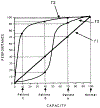A maximum likelihood procedure for the analysis of group and individual data in aphasia research
- PMID: 1709815
- PMCID: PMC9782755
- DOI: 10.1016/0093-934x(91)90126-l
A maximum likelihood procedure for the analysis of group and individual data in aphasia research
Abstract
The limitations inherent in group versus case studies appear to lie in a complementary distribution, underscoring the importance of combining both strategies within a single research program. However, this compromise approach requires analytic tools that permit us to combine and evaluate individual and group data in a common format. Maximum likelihood estimation (MLE) belongs to a family of procedures for determining goodness of fit. MLE can be used in conjunction with a linear or nonlinear model of the way that sources of information combine to determine a given behavioral outcome; such models can be used to estimate the distance between two groups, the degree to which an individual case deviates from a given empirically or theoretically defined group profile, and the degree to which one individual case resembles another. We offer a demonstration of how MLE can be used to evaluate group and individual profiles, in a cross-linguistic study of sentence comprehension in nonfluent aphasic speakers of English, Italian, and German. This includes a demonstration in which the MLE models for each language are "lesioned" to simulate several competing accounts of receptive agrammatism.
Figures




Comment in
-
Data, statistics, and theory: a comment on Bates, McDonald, MacWhinney, and Applebaum's "A maximum likelihood procedure for the analysis of group and individual data in aphasia research".Brain Lang. 1991 Jul;41(1):43-51. doi: 10.1016/0093-934x(91)90109-e. Brain Lang. 1991. PMID: 1715799 No abstract available.
Similar articles
-
Comprehension in aphasia: a cross-linguistic study.Brain Lang. 1987 Sep;32(1):19-67. doi: 10.1016/0093-934x(87)90116-7. Brain Lang. 1987. PMID: 3651807
-
There is an entity called agrammatic aphasia.Brain Lang. 1991 Nov;41(4):555-64. doi: 10.1016/0093-934x(91)90174-y. Brain Lang. 1991. PMID: 1723333 Review.
-
Syntactic and semantic contributions to sentence comprehension in agrammatism.Brain Lang. 1989 Oct;37(3):419-39. doi: 10.1016/0093-934x(89)90029-1. Brain Lang. 1989. PMID: 2478253
-
Sentence interpretation in normal and aphasic Hindi speakers.Brain Lang. 1991 Aug;41(2):250-74. doi: 10.1016/0093-934x(91)90155-t. Brain Lang. 1991. PMID: 1718532
-
Agrammatism is a theoretically coherent aphasic category.Brain Lang. 1991 Feb;40(2):274-81. doi: 10.1016/0093-934x(91)90128-n. Brain Lang. 1991. PMID: 1709816 Review. No abstract available.
Cited by
-
A psychometric analysis of functional category production in English agrammatic narratives.Brain Lang. 2008 Apr;105(1):18-31. doi: 10.1016/j.bandl.2007.12.008. Epub 2008 Feb 5. Brain Lang. 2008. PMID: 18255135 Free PMC article.
-
The changing relationship between anatomic and cognitive explanation in the neuropsychology of language.J Psycholinguist Res. 1998 Mar;27(2):147-65. doi: 10.1023/a:1023293814792. J Psycholinguist Res. 1998. PMID: 9561783 Review.
-
Sentence processing in children with early unilateral brain injury.Brain Lang. 2002 Nov;83(2):335-52. doi: 10.1016/s0093-934x(02)00037-8. Brain Lang. 2002. PMID: 12387801 Free PMC article.
-
Rational integration of noisy evidence and prior semantic expectations in sentence interpretation.Proc Natl Acad Sci U S A. 2013 May 14;110(20):8051-6. doi: 10.1073/pnas.1216438110. Epub 2013 May 1. Proc Natl Acad Sci U S A. 2013. PMID: 23637344 Free PMC article.
-
Can neuroimaging help aphasia researchers? Addressing generalizability, variability, and interpretability.Cogn Neuropsychol. 2017 Sep;34(6):377-393. doi: 10.1080/02643294.2017.1402756. Epub 2017 Nov 30. Cogn Neuropsychol. 2017. PMID: 29188746 Free PMC article.
References
-
- Badecker W, & Caramazza A 1985. On considerations of method and theory governing the use of clinical categories in neurolinguistics and cognitive neuropsychology: The case against agrammatism. Cognition, 20, 97–125. - PubMed
-
- Badecker W, & Caramazza A 1986. A final brief in the case against agrammatism: The role of theory in the selection of data. Cognition, 24, 277–282. - PubMed
-
- Basso A, Capitani E, Laiacona M, & Luzzatti C 1980. Sex differences in recovery from aphasia. Cortex, 16, 631–636. - PubMed
-
- Basso A, Capitani E, & Vignolo L 1979. Influence of rehabilitation on language skills in aphasic patients: A controlled study. Archives of Neurology, 36, 190–196. - PubMed
-
- Bates E, Friederici A, & Wulfeck B 1987. Comprehension in aphasia: A crosslinguistic study. Brain and Language, 32, 19–67. - PubMed
Publication types
MeSH terms
Grants and funding
LinkOut - more resources
Full Text Sources
Medical

